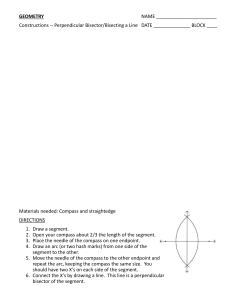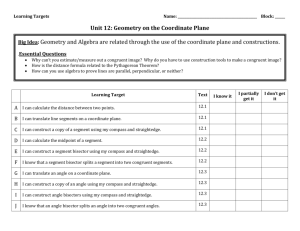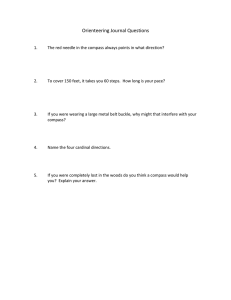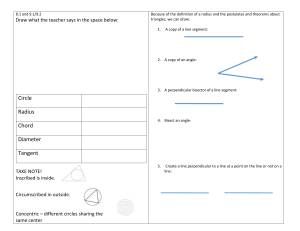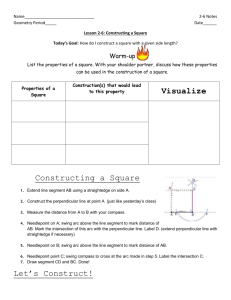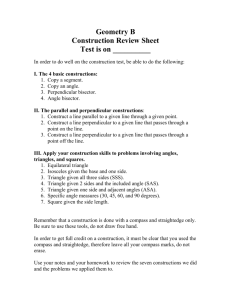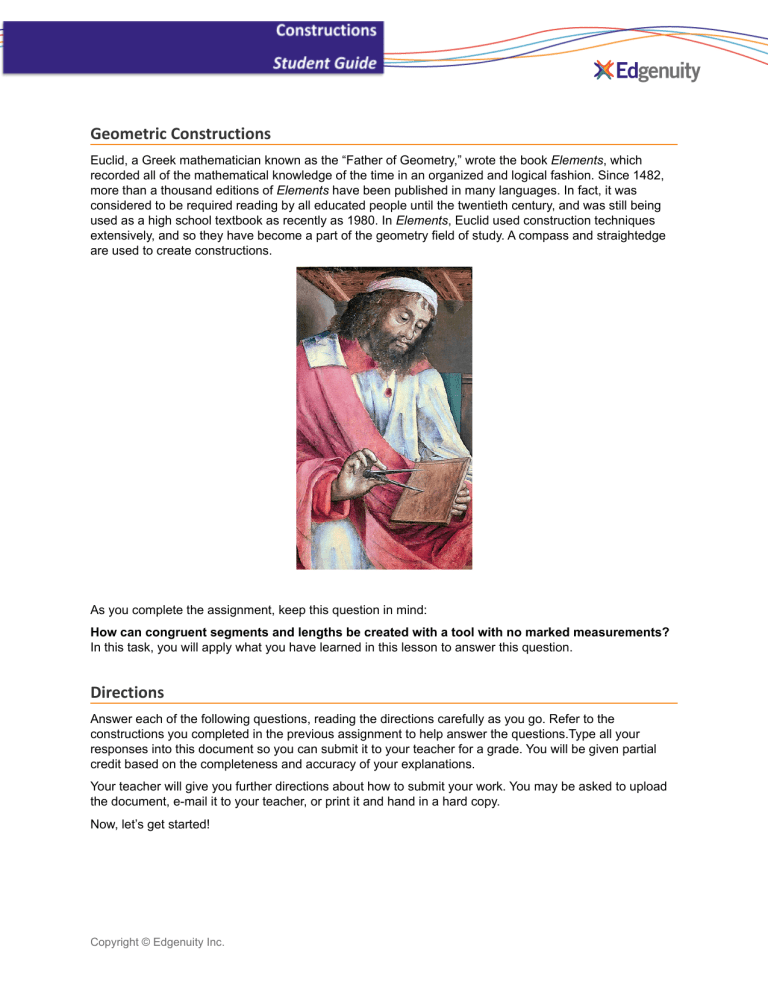
Geometric Constructions Euclid, a Greek mathematician known as the “Father of Geometry,” wrote the book Elements, which recorded all of the mathematical knowledge of the time in an organized and logical fashion. Since 1482, more than a thousand editions of Elements have been published in many languages. In fact, it was considered to be required reading by all educated people until the twentieth century, and was still being used as a high school textbook as recently as 1980. In Elements, Euclid used construction techniques extensively, and so they have become a part of the geometry field of study. A compass and straightedge are used to create constructions. As you complete the assignment, keep this question in mind: How can congruent segments and lengths be created with a tool with no marked measurements? In this task, you will apply what you have learned in this lesson to answer this question. Directions Answer each of the following questions, reading the directions carefully as you go. Refer to the constructions you completed in the previous assignment to help answer the questions.Type all your responses into this document so you can submit it to your teacher for a grade. You will be given partial credit based on the completeness and accuracy of your explanations. Your teacher will give you further directions about how to submit your work. You may be asked to upload the document, e-mail it to your teacher, or print it and hand in a hard copy. Now, let’s get started! Copyright © Edgenuity Inc. Student Guide (continued) Step 1: Copy a segment and an angle. a) Which step in the construction of copying a line segment ensures that the new line segment has the same length as the original line segment? In the construction of copying a line segment, the steps conclude the following: set the compass to the length of the segment (opening the compass), direct the compass point on the points, draw an arc with the same compass settings, then the new line segment is formed. The significance of following the steps and not changing the compass settings and width are still crucial, the step that ensures the new line segment has the same length as the original line segment is using a compass and drawing the arc. b) Explain how you could use the construction tool or a compass and straightedge to create a line segment that is twice as long as 𝐴𝐵. Using a construction tool or a compass and a straightedge, measure the length of AB , place the center of the compass on B, and just like stated in a, do not adjust the width of the compass. Then, make the arc with the same distance, and mark the new point of intersection as C. Therefore,the new line segment is twice the length of AB. Copyright © Edgenuity Inc. Student Guide (continued) c) The construction of copying ∠𝑄𝑃𝑅 is started below. The next step is to set the width of the compass to the length of 𝐴𝐵. How does this step ensure that the new angle will be congruent to the original angle? The crucial step of setting the width of the compass to the length of AB ensures the new angle will be congruent to the original angle is due to the congruence theorem. The property of congruence states that two angles are congruent if they have equal measures. The step of setting the width of the compass to the length of 𝐴𝐵 guarantees the property being applied into making the new angle to be congruent to the original angle. d) How is copying a line segment similar to copying an angle? Copying a line segment is similar to copying an angle as both require using the same compass settings or width; A fixed compass to have the same measure. When a line segment is copied to a new segment, it will have the same measure. When copying an angle to a new angle, it will have the same measure. Copyright © Edgenuity Inc. Student Guide (continued) Copyright © Edgenuity Inc. Student Guide (continued) Step 2: Construct a perpendicular line. a) In the step shown of the construction of a line through a point that is perpendicular to the given line, why must the compass point be placed on points A and B? How would the construction be different if the compass point were placed at random points on the original line? The construction would be different if the compass point were placed at random points on the original line because making arcs make the perpendicular line; If it were to placed at random points it would not be centered like in the figure below and must be placed on points A and B to make the line line up correctly. Copyright © Edgenuity Inc. Student Guide (continued) Step 3: Construct an angle and a perpendicular bisector. a) The construction of creating the perpendicular bisector of 𝑃𝑄 is started below. How would the construction be different if you changed the compass setting in the next step of the perpendicular bisector construction? Just like in the label “construction of creating the perpendicular bisector”, the reasoning as to why the construction would be different if the compass settings is directly stated. A perpendicular bisector divides a line segment into two equal segments. The compass must be positioned in the same compass setting in the next step, otherwise if not, the model will not be perpendicular and the construction will be different. Copyright © Edgenuity Inc.
